Navigate This Post
To many people, the idea of a muzzleloading rifle or shooting a muzzleloader seems about as foreign as hitching up a horse to a buggy and taking a ride into town. Black powder rifles seem archaic, an antiquated tool of days gone by.
Others might be drawn to the idea of shooting muzzleloading rifles, but they view the process as too complicated or complex. Perhaps they overheard a repeated tale in a gun shop about a catastrophic accident where a muzzleloader supposed “blew up”.
I am here to assure you that learning to effectively shoot a muzzleloading rifle is not as difficult as it might seem. It is also a perfectly safe recreation if you take the time to do it correctly.
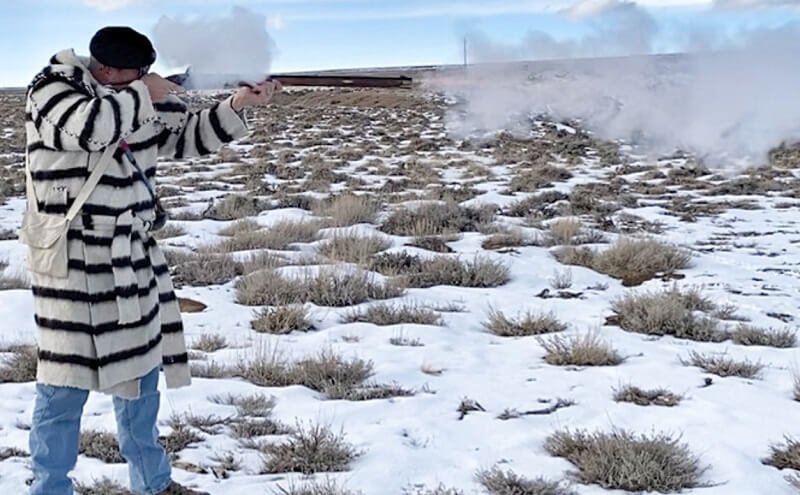
The Author firing his flintlock rifle.
Why Should I Shoot a Muzzleloading Rifle?
Help us combat Censorship by joining our Newsletter
There are actually several reasons why you might be attracted to shooting a muzzleloader. One of the first recommendations for a black powder rifle is gaining a historical appreciation for what our ancestors used. It is hard to truly acknowledge or recognize the importance of the self-contained cartridge until you consider that for hundreds of years, the best method we had was the muzzleloading rifle or musket.
Many experienced adults will begin muzzleloading because it is a way to extend their annual hunting season. In most, if not all, states, there are designated muzzleloading or primitive weapon hunting seasons. These seasons are set aside just for people who wish to use traditional arms. When compared to “gun season” the woods and fields are generally much less crowded during muzzleloader season.
One more reason to take up muzzleloading is that it can be a most enjoyable recreation. Many shooters begin shooting a black powder rifle because it is a new challenge and it is something out of the norm.
Where Do I Begin? My First Muzzleloader.
When you decide to look into muzzleloading you will find that there are so many options that getting started might seem a bit daunting. Modern muzzleloading rifles come in sidelock cap firing, inline primer firing, flintlock and other styles. Step number one; understand that “lock” refers to the firing mechanism of the weapon itself.
Flintlock.
The oldest style that you will likely find is the flintlock. A piece of flint is held in a cock mechanism and strikes against a steel frizzen to create sparks. The sparks set off a small powder charge which in turn ignites a large powder charge that launches the ball. A flintlock is the most detailed or intense way to get into black powder shooting.
Caplock.
A caplock gun uses a primer cap that is fitted over an offset nipple. The hammer strikes the primer cap which sends a spark through the nipple and into the barrel thus igniting the main powder charge.
Inline.
The most modern type of muzzleloading rifle in one that uses a #209 shotgun primer. The primer is fitted into a firing channel that is “in line” with the bore of the gun. When the #209 primer is struck by a modern firing pin, it ignites and sets off the powder in a similar fashion to a cartridge.
A quick search of what is available today will show that as far as “modern” muzzleloading goes, the inline-style that uses #209 primers is the preferred choice of those who want to hunt and extend their deer season. Traditions Firearms, Connecticut Valley Arms/CVA, and Thompson Center are all companies that offer a variety of muzzleloading rifles.
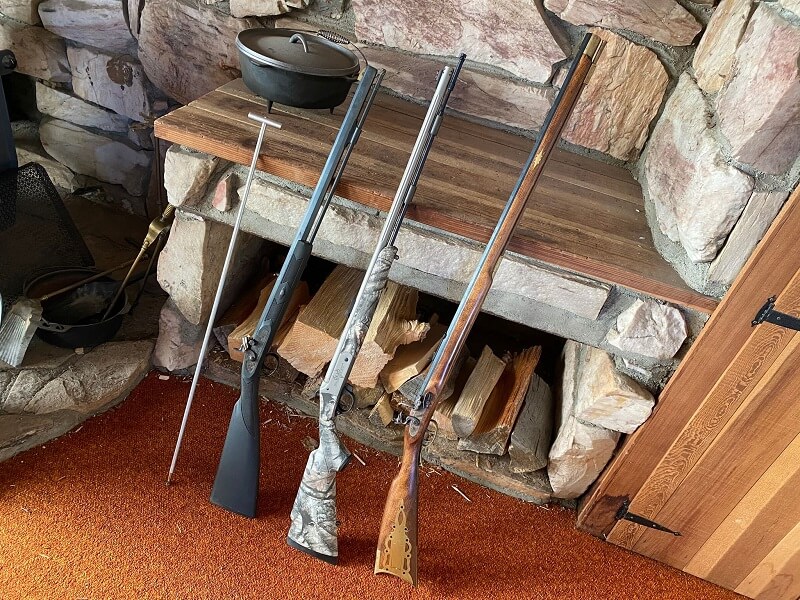
L to R: Range Rod, CVA Caplock rifle, Traditions Inline rifle, Traditions Flintlock rifle.
What Do You Need to Start Muzzleloading?
In addition to the actual muzzleloading rifle, you will need some components and accessories. In order to load your gun, you will need a loading rod or ramrod. All muzzleloaders come with a loading rod. I can tell you from about three decades of experience that the rod that comes with the guns are functional, but not the best quality. If you really want to enjoy your shooting experience with a muzzleloading rifle, you will want to spend the money and buy what is called a “Range Rod”. A range rod is a stout, well made loading rod that is threaded to accept a variety of rod accessories. Also, you will want to pick up a device called a “Ball starter” or a “Short Starter”.
Projectiles or ammunition are also a must have. You will need either black powder (FF or FFF) or some type of black powder substitute such as Hodgdon Triple 7 or Pyrodex. These are the most common. A container or powder horn to pour your powder out for measuring are also a requirement.
You will also need a powder measure designed for muzzleloading NOT smokeless powder reloading. There is a difference. If you are shooting round lead balls you will need shooting patches. If you are shooting conical bullets, you will need plastic sabots
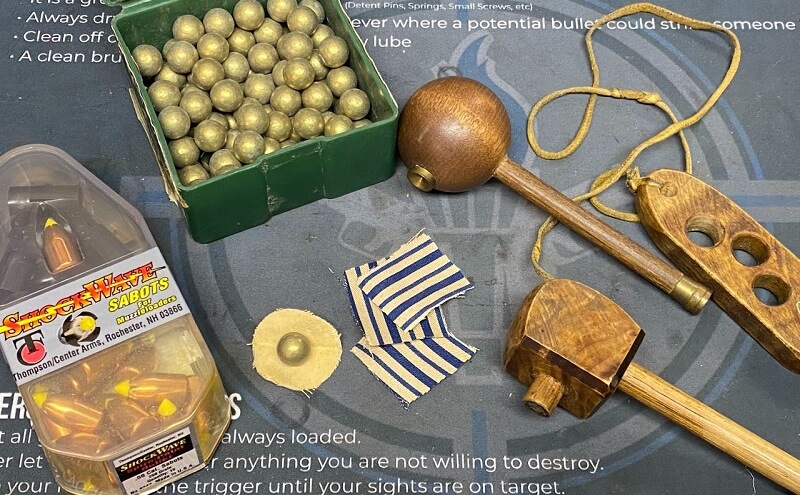
Bullets and Balls along with patches and ball starters.
More Accessories You Need for Muzzleloading.
Speaking of accessories, you will need a cleaning jag in the corresponding size of your rifle. Of all the modern guns, .50 caliber muzzleloaders are the most popular and prevalent today. Guns in .54 caliber come in next. All other calibers are more specialized. If you are a beginner, I would recommend that you stick to .50 caliber guns. The cleaning jag holds a cleaning patch that you must use to scrub the carbon and unburnt powder out of the bore of your rifle. Occasionally, the cleaning patch will come off of the jag and you will need to get it out of the barrel. A device called a “patch worm” or “patch remover” will remove the patch easily.
For a caplock gun, you will want some type of “nipple pick” to clean out the carbon and powder fouling from your nipple. A clogged/blocked nipple hole is often the reason why a caplock fails to fire.
Maintenance, Maintenance and more Maintenance.
Muzzleloaders are dirty guns, this is true whether you use genuine black powder or some kind of black powder substitute. You absolutely must clean your guns thoroughly after shooting them. Black powder and other smoke creating powders are hygroscopic. That means they attract and hold moisture. Powder residue left on steel will attract any available moisture and then we encounter the scientific term; oxidation, better known as rust. It is easy to see where your cleaning efforts were substandard when you pull your muzzleloader out of the safe after a month and find brown rust spots.
As soon as you buy your muzzleloading rifle, buy a dedicated cleaning kit from CVA, Thompson Center, or Traditions Firearms (linked above). No, a normal gun cleaning kit is not the same thing. You need a cleaning kit designed for muzzleloading firearms.
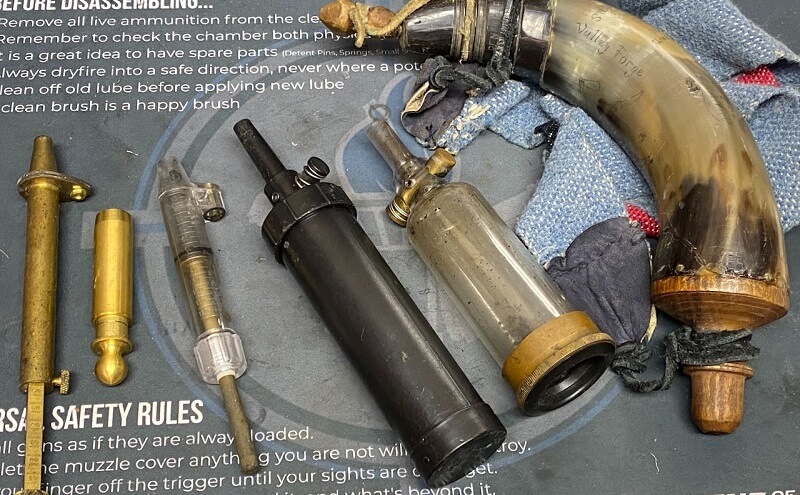
Powder measures and powder containers.
How to Load a Muzzleloading Rifle.
As the name indicates, a muzzleloading rifle is loaded from the front, the muzzle, to the back, the breach. Let’s keep it simple and assume you are using a .50 caliber, caplock muzzleloader. The gun is clean, empty and read to go. Here’s the step by step process.
- One: The gun must be vertical, muzzle pointing up. Measure your powder into a dedicated powder measuring device. NEVER guess or dump powder from your horn/contain straight into the barrel. If you are a new shooter, measure out 50 grains of powder in the measurer and pour it down the barrel.
- Two: Place the ball on top of a shooting patch on the muzzle. Whack the ball starter with the palm of your hand to push the ball into the bore. Now take the range rod and ram the ball all the way down against the powder. *CAUTION: failure to seat the ball against the powder will leave an air gap, that gap creates a fail point that can cause a barrel to violently rupture.
- Three: Point the rifle downrange and place a primer cap over the nipple. NOTE: always cap last, not first.
- Four: Cock the hammer, aim at the target, squeeze the trigger, follow through.
- Five: Unless the Indians are coming to scalp you, take the time to run a cleaning patch down the bore of your gun before you load another round.
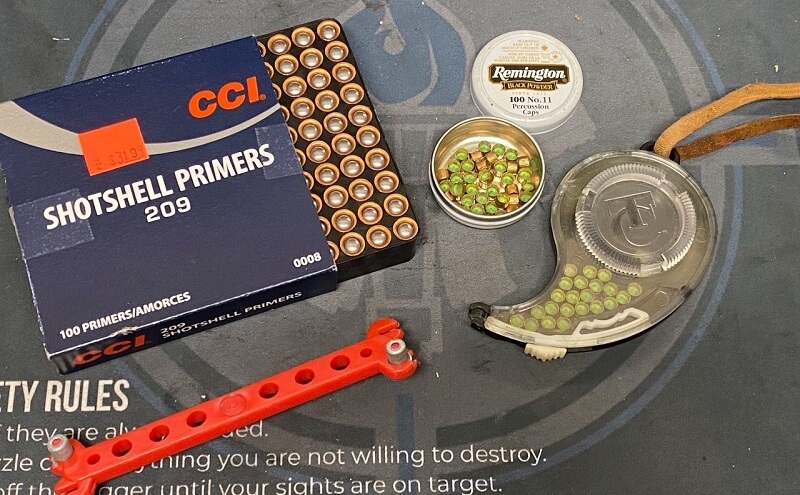
Various primers for muzzleloaders.
Dealing with a Muzzleloader Misfire.
Most importantly, you must remember to keep your muzzle pointed down range if the gun does not go off immediately. There is also a difference between a hangfire and a misfire. A hangfire occurs when the cap or primer powder ignites and there is a perceptible time delay; and half to a full second before the gun fires. A hangfire is why you keep your muzzle oriented down-range.
A misfire is when the cap or primer powder ignites, but after two to three seconds the gun has not fired. The main cause of a caplock misfire is a misaligned primer cap. The second most common cause is a blocked or clogged nipple. If the cap snaps, but the gun fails to fire, hold the muzzle down range for 2 to 3 seconds. Next, with the muzzle still down range, install a fresh cap, ensure it is seated properly, and attempt to fire. This should work.
If the gun again fails to fire, repeat the above steps, but this time attempt to clean the firing hole in the nipple with a nipple pick before putting a new cap on it. Attempt to fire again. If the gun still does not fire, you probably forgot to put powder in the barrel. Seek out the help of an experienced professional.
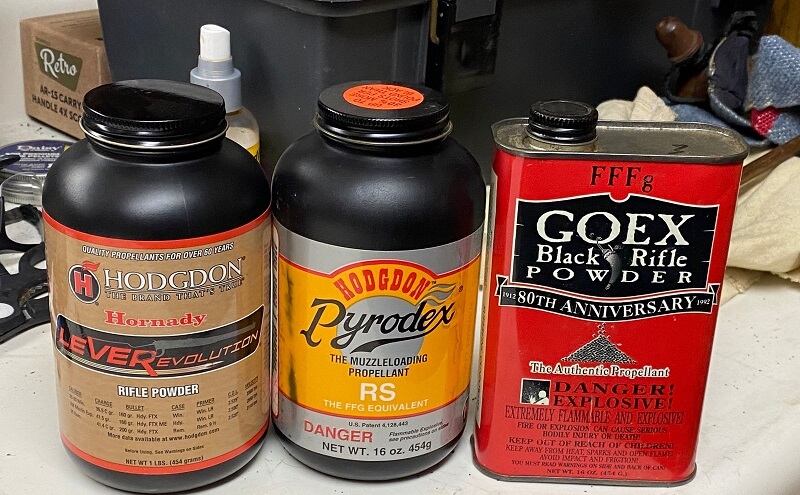
Powder for muzzleloaders; Triple 7 and Pyrodex plus genuine black powder.
Parting Shots on Muzzleloading.
I started on my muzzleloading journey better than twenty years ago when I participated in a Muzzleloader Instructor course. During the decades that followed, I’ve taught adults and young people to safely and effectively shoot muzzleloading guns.
As I mentioned earlier, if this is your first time with a muzzleloader, keep it simple. A caplock or inline .50 caliber gun is a good way to start. After you have gained some experience, you might want to move into flintlock guns or even muzzleloading handguns.
Given the current situation with ammunition and firearms in the United States, a muzzleloading gun may be both economical and enjoyable. If you like to shoot and are looking for a challenge, muzzleloading might be a good fit for you.
FREE COURSE
Master the Fundamentals with 7 Training Tips That Could Save Your Life
Sign up now and get started with the course.
Professor Paul Markel
Latest posts by Professor Paul Markel (see all)
- Tactical Masturbation: Top 3 Stupid Human Tricks - July 8th, 2024
- Blood Trail: Fearless Fiction - June 21st, 2024
- SOTG and SB Tactical Celebrate Brace Ruling - June 20th, 2024
- Shotgun Accessories: Practical and Useful - June 14th, 2024
- Tactical Rifle Tips: Transition Drills - January 5th, 2024






Excellent, brief article. I got into muzzle loading shooting about 8 years ago. Prior to that I shot mainly pistol, competitively and just for fun. A friend coerced me into shooting with the group one Friday and I was hooked. I’ve had the pleasure of shooting rifle, pistol (Trapper and Revolver) and shot gun black powder. The experience is far different from emptying a mag and requires a disciplined approach but it definitely fun. Shooting flies at 25 yards, steel up to 50 yards, cutting playing cards – you can have fun. I still shoot pistol and modern rifles but I have now included black powder to my routine.
Thanks for reading!
Prof Paul,
Thank you for writing Muzzleloading Basics. It was done very well as usual.
I have been shooting front-stuffers for many years, flintlocks, caplocks, even been Canonized thru the NMLRA and National Park Service. Also have a small 1lb canon on a field carriage myself and serve on a War of 1812 3lb gun crew.
Have you thought about publishing this in modern gun magazines as well as the NMLRA Muzzle Blasts and Muzzleloader?
This could be a good recruitment tool for local BP clubs as well.
Also can I have your permission to send this to other members of the shooting and reenacting club, Fort LaMotte Rangers, Palestine, IL, I am the current Pres of?
Thank You.
Hi Charlie. Use this material as you see fit, please credit Student of the Gun and Paul Markel when doing so. Thanks for reading!